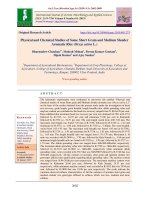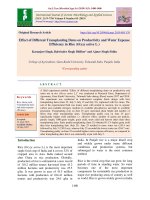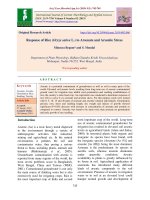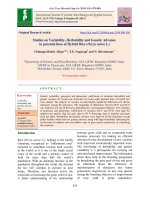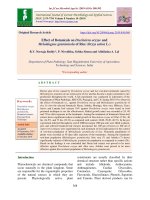Assessment of yield limiting nutrients through response of rice (Oryza sativa L.) to nutrient omission in inceptisols of Bastar district of Chhattisgarh State in India
Bạn đang xem bản rút gọn của tài liệu. Xem và tải ngay bản đầy đủ của tài liệu tại đây (246.32 KB, 9 trang )
Int.J.Curr.Microbiol.App.Sci (2018) 7(8): 3972-3980
International Journal of Current Microbiology and Applied Sciences
ISSN: 2319-7706 Volume 7 Number 08 (2018)
Journal homepage:
Original Research Article
/>
Assessment of Yield Limiting Nutrients through Response of Rice
(Oryza sativa L.) to Nutrient Omission in Inceptisols of Bastar District of
Chhattisgarh State in India
Bhupendra Kumar1, G.K. Sharma1*, V.N. Mishra2, T. Chandrakar1, A. Pradhan1,
D.P. Singh1 and A.K. Thakur1
1
Shaheed Gundadhur College of Agriculture and Research Station, Jagdalpur- 494 005
(Chhattisgarh), India
2
College of Agriculture, Indira Gandhi Krishi Vishwavidyalaya, Raipur- 492 012
(Chhattisgarh), India
*Corresponding author
ABSTRACT
Keywords
Site specific nutrient
management, Yield
limiting nutrients,
Nutrient omission pot
technique
Article Info
Accepted:
22 July 2018
Available Online:
10 August 2018
The investigation was under taken during kharif and rabi season 2017-18 at Shaheed
Gundadhur College of Agriculture and Research Station, Jagdalpur (Chhattisgarh). The pot
experiment, during kharif season with transplanted rice, was laid out under Completely
Randomized Design (CRD) with three replications and 11 treatments comprised with
keeping one treatment of application of all nutrients (N, P, K, S, Ca, Mg, Cu, Zn, B, and
Mo) in optimum level and other treatments were formulated by sequentially omitting each
nutrient from all nutrients applied. The result revealed that the omission of nutrients N, P
and S significantly reduced the plant height, tillers pot-1, effective tillers pot-1, filled grains
panicle-1, grain and straw yield of rice and uptake of N, P, K, S, Ca, Mg, Cu, Zn, Mn, Fe
and B by rice in comparison to treatment that received all nutrients. The highest grain yield
66.4 g pot-1 were recorded under the treatment receiving all the nutrients and that of lowest
grain yields 34.8 pot-1 were recorded under omission of N, followed by omission of P (42.5
pot-1) and S (56.3 pot-1) nutrients. Based on these results of kharif season, the limiting
nutrients were identified as N, P, and S. These nutrients were applied at the rate of 150 kg
N, 100 kg P2O5, 100 kg K2O, 45 kg S ha-1. This dose, known as SSNM dose was tested at
farmers field, from where the bulk soils were collected for pot experiments, with wheat
crop during rabi season 2017-18. SSNM dose resulted in higher grain yield of wheat in
comparison to that of farmer’s fertilizer doses at the rate of 80 kg N: 50 kg P 2O5: 0 kg K2O
ha-1. About 13.3 % increase in the wheat grain yield were recorded due to SSNM dose
based on identified yield limiting nutrients over farmer's practice dose.
Introduction
Soil fertility evaluation is the key factor for
adequate and balanced fertilization of crops in
high crop production systems. Soil and plant
analyses are commonly performed to assess
the fertility status of a soil with other
diagnostic techniques including identification
of deficiency symptoms and biological tests
which are helpful in determining specific
3972
Int.J.Curr.Microbiol.App.Sci (2018) 7(8): 3972-3980
nutrient stresses and quantity of nutrients
needed to optimize the yield (Havlin et al.,
2007). However, the analytical results do not
indicate the most limiting nutrient according
to Liebig's law of the minimum “the minimum
nutrient is the factor that governs and controls
growth and potential yield of crop”. The
nutrient omission pot trial provides a visible
order of crop response to nutrient application.
It aims to find out the most limiting nutrients
to the growth of a crop plant. If any element is
omitted while other elements are applied at
suitable rates and plants grow weakly, then the
tested element is a limiting factor for crop
growth. Conversely, if any element is omitted
but plants are healthy, then that element is not
a limiting factor for crop production.
The site-specific nutrient management
(SSNM) strives to enable farmers to
dynamically adjust fertilizer use to optimally
fill the deficit between the nutrient needs of a
high-yielding crop and the nutrient supply
from naturally occurring indigenous sources
such as soil, organic amendments, crop
residues, manures, and irrigation water. The
SSNM approach does not specifically aim to
either reduce or increase fertilizer use. Instead,
it aims to apply nutrients at optimal rates and
times to achieve high yield and high efficiency
of nutrient use by the rice crop, leading to high
cash value of the harvest per unit of fertilizer
invested.
Among the various cropping systems, rice
based cropping systems are the predominant
systems in India. Managing the variability in
soil nutrient supply that has resulted from
intensive rice cropping is one of the
challenges for sustaining and increasing rice
yield in India. The use of plant nutrients in a
balanced manner is the prime factor for
efficient fertilizer program. Balanced nutrient
use ensures high production level and helps to
maintain the soil health and ensures
sustainable agriculture (Sahu et al., 2017).
Rice is the most important and extensively
cultivated food crop, which provides half of
the daily food for one of every three persons
on the earth. In our country, more than 40
million hectares area are covered under rice
cultivation and total production has crossed
100 million tonnes. Rice production in India is
an important factor for food security.
However, little is known about the
sustainability of the current production
systems, particularly systems with triple
cropping under minimum practice. Among the
various cropping systems, rice based cropping
systems are the predominant systems in India.
Managing the variability in soil nutrient
supply that has resulted from intensive rice
cropping is one of the challenges for
sustaining and increasing rice yield in
India.Looking to very limited information on
the proper and site specific nutrient doses to
maximize yield of rice, present investigation
was undertaken with the objective to assess
the yield limiting nutrients based on rice response using nutrient omission technique
and to demonstrate the optimum use of
identified limiting nutrients and its
comparison with farmer’s fertilizer practice.
Materials and Methods
Apot culture investigation for assessment of
yield limiting nutrients in soil was undertaken
during the year of kharif season 2017at the
green house of Section of Soil Science and
Agricultural Chemistry, Shaheed Gundadhoor
College of Agriculture and Research Station,
Jagdalpur,
Bastar
(Chhattisgarh)
and
subsequently at farmers field of village –
Dharmaur, block - Tokapal, District –Bastar
for verification of the results of pot
experiment. The study site lies at 19010’ N
latitude and 81095 E longitude with an altitude
of 550-760 meter above the mean sea level.
The pot experiment, during kharif season with
transplanted rice, was laid out under
Completely Randomized Design (CRD) with
3973
Int.J.Curr.Microbiol.App.Sci (2018) 7(8): 3972-3980
three replications and 11 treatments comprised
by keeping one treatment (T1) with application
of all nutrients (N, P, K, S, Ca, Mg, Cu, Zn, B,
and Mo) in optimum level and other
treatments were formulated by sequentially
omitting each nutrient from T1 where all
nutrients were applied (SSNM).
Before conducting the experiment, the bulk
soil samples representative of Inceptisol of the
district was collected from the farmer's fields
for pot culture experiment to identify the yield
limiting nutrients.The initial physicochemical
characteristics of the experimental soil
(Inceptisol) was determined (Table 1) using
common field and laboratory procedures.The
mechanical analysis showed that the texture of
soil under investigation was a sandy clay
loam. The initial status of soil pH was,
recorded as slightly acidic (6.3). Electrical
Conductivity (EC) were estimated as (0.13
dsm-1) and rated as normal. The organic C was
estimated as medium in the soils where it was
rated as low. Available N, P and S was
estimated as low. Status in available K was
rated as medium and that of available Ca and
Mg was high. The available Zn was rated as
marginal and the available boron status of the
soils was rated aslow, however, the
availability of Fe, Mn and Cu was rated as
high.
The processed and uniformed soil samples
were filled in plastic pots @ 20 kg and
nutrients as specified above were applied
through different sources taking care to avoid
any precipitation during solution mixing and
application. The optimum doses of nutrients
were fixed in kgha-1 as N -150, P2O5- 100,
K2O - 100, S - 45, Ca- 110, Mg- 50, Fe - 20,
Mn - 7.5, Cu - 7.5, Zn -7.5, B - 3 and Mo 0.75 for SSNM dose. Rice (MTU-1001) was
taken as test crop. The pots were maintained
saturation with standing water and twenty five
days old seedlings of rice (MTU-1001) were
transplanted on 22th July 2017. Three
seedlings of MTU-1001 variety of rice were
planted in three hills in each pot and water
level was maintained at 3 cm throughout the
crop season. Thereafter, full dose of all the
nutrients except nitrogen was added to the soil
in solution form. Nitrogen as urea was applied
in three splits at transplanting, tillering and
panicle initiation stage. The effects of
treatments were recorded in terms of yield,
different yield attributing parameters and
nutrient uptake by rice crop. Based on these
results, N, P and S were identified as yield
limiting nutrients. The optimum use of
identified limiting nutrients was verified at
farmer's field, from where the bulk soil was
collected, with wheat variety GW-273 as a test
crop during rabi season 2017-18 and the
effects of optimum/SSNM dose was compared
with farmer's fertilizer practice.
Results and Discussion
Yield and yield attributing parameters
Plant height
Omission of different nutrients had a
significant effect on plant height of rice crop
in Inceptisol at Bastar district (Table 2). Plant
height is one of the most important
characteristics which indicate nutrients
absorption capacity as well as health of the
soil and plant.The highest plant height of rice
was recorded under treatment T1where all the
nutrients were supplied, whereas, significantly
lower plant height were recorded under the
treatments missing N, P and S nutrients, as
compared to T1indicating the need of
application of these nutrients in Inceptisols of
the region. Since N is an important constituent
of amino acids, proteins and protoplast, its
application had a more pronounced effect on
plant growth and development through better
utilization of photo-synthates and more
vegetative growth. These results are in
conformity of the findings of Sharma et al.,
3974
Int.J.Curr.Microbiol.App.Sci (2018) 7(8): 3972-3980
(2000). P omission had also exhibited a
significant effect on plant height. Optimum P
availability is essential for normal growth and
development and the utilization of other
nutrients, particularly N. The significant crop
response to P application was also reported by
many workers (Ahmed et al., 2010 and Mc
Beath et al., 2007).
Tillers per pot
The results presented in the table 2 show the
effects of nutrients omission on tillers pot-1of
rice recorded at 60 DAT in Inceptisol of
Bastar district. Significantly higher number of
tillers was observed at treatment T1 that
received all the nutrients. However, N, P and
S nutrients omission treatments showed
significantly less number of tillers in
comparison to treatment T1.
N plays a key role in tillers bearing of rice
followed by P. On an average, 23 tillers were
observed at 60 DAT with T1 treatment which
received all nutrients and various nutrients
omission treatments had reduced number of
tillers. Omission of N and P reduced the
number of tillers as these two nutrients have
major role in tillers bearing of the crop.
Effective tillers pot-1
Grain yield of cereals is highly dependent
upon the number of effective tillers. The data,
pertaining to number of effective tillers per
pot, presented in Table 2 was ranged from
12.3 to 19.3. Omission of different nutrients
significantly reduced the number of effective
tillers of rice.
The highest numbers of effective tillers were
observed in treatment T1 that received all
nutrients. Omission of N, P and S nutrients
significantly reduced the effective tillers of
rice, as compared to T1 that received all
nutrients.
Filled grains panicle-1
The data presented in Table 2 showed that the
number of filled grainpanicle-1as affected by
various treatments varied from 113.7 to 137.0.
Treatment T1 which received all nutrients
recorded significantly highest number of filled
grains per panicle. Omission of N, P and S
significantly reduced the filled grains per
panicle, as compared to T1.
Test weight
Test weight (weight of 1000 rice seed) of rice
did not differ significantly with respect to the
application of different treatments in this
study. However, omission of N and P pots had
reduced the test weight as compared to those
of all other treatments. It is universally truth
that N and P are the most important major
nutrients require for tillering, root growth and
general plant vigour that affect ultimately
filled grains and test weight. The reduced
effective tillers, number of filled grains per
panicle and test weight were recorded in
present study caused due to omission of N and
P treatments (Table 2).
Grain yield
The data pertaining to effect of nutrient
omission on grain yields of rice in Inceptisol
of Bastar district are illustrated in (Table 1).
The rice grain yields were influenced
significantly with the imposition of different
nutrient omission treatments. The highest
grain yield (66.4 g pot-1) were recorded under
the treatment receiving all the nutrients (T1)
and that of significantly lower grain yields
(34.8 g pot-1) in comparison to T1, were
recorded under omission of N followed by
omission of P (42.5 g pot-1) and S (56.3 g
pot-1) nutrients. In other treatments, grain
yields were observed statistically at par in
comparison to treatment T1where all the
nutrients were supplied to rice crop.
3975
Int.J.Curr.Microbiol.App.Sci (2018) 7(8): 3972-3980
Grain yield reduction
The reduction of rice grain yield because of
omission of different plant nutrients, from
treatment T1 (where all the nutrients applied),
were also worked out (Table 2). The yield
limiting nutrients which reduced the yield by
about 10% from the maximum yield obtained
by treatment T1 are critically observed. It was
noticed that omission of N from SSNM dose
reduced the grain yield by 47.6 % and that of
P omission caused a yield reduction of 35.9%.
Apart from the omission of N and P, yield
reductions due to S and Zn omission were also
noticed. It was observed that S omission
reduced rice yield by 15.1 % and Zn omission
11.7 %. Percent reduction in rice grain yields
under different nutrient omitted pots as
presented in Table 1 may be put in the order of
N > P > S >Zn. Large reductions in the grain
yield of rice were observed with the omission
of N and P as compared to the other nutrient
omission treatments. The yield reductions
were more pronounced with N omission.
Result clearly indicates that N is the most
critical nutrients that affect the grain yield
considerably in all the soils followed by P.
Omission of all other nutrients did not indicate
yield reduction, statistically significantly
except, omission of S.
Straw yield
It is evident from the data in (Table 2) that the
mean straw yields of rice were significantly
affected with imposition of different nutrient
omission treatments. Omission of N, P and S
significantly reduced the straw yield as
compared to treatment T1 where all the
nutrients were supplied. The highest straw
yield (82.3 g pot-1) of rice was observed in
treatment T1where all the nutrients were
applied and lowest (44.2 g pot-1) in T2
treatment where N was omitted.
Table.1 Initial physicochemical characteristic of experimental soil
S. No.
1.
2.
3.
4.
5.
6.
7.
8.
9.
10.
11.
12.
13.
14.
15.
Soil Characteristics
Mechanical composition
Sand (%)
Clay (%)
Silt (%)
pH(1:2.5 soil: water ratio)
EC (dS m-1)
Organic C (%)
Available N (kg ha-1)
Available P (kg ha-1)
Available K (kg ha-1)
Available Ca (kg ha-1)
Available Mg (kg ha-1)
Available S (kg ha-1)
Available Zn (ppm)
Available Cu (ppm)
Available Mn (ppm)
Available Fe (ppm)
Available B (ppm)
3976
Value
Rating
54
20
26
6.3
0.13
0.52
242
10.84
182
1062
463
17.7
0.74
1.45
27.30
38.90
0.47
Sandy Clay Loam
slightly acidic
normal
medium
low
low
medium
high
high
low
marginal
high
high
high
low
Int.J.Curr.Microbiol.App.Sci (2018) 7(8): 3972-3980
Table.2 Effect of nutrient omission on yield and yield attributes of rice (MTU-1001) in Inceptisol of Bastar Plateau
Treatment
T1
T2
T3
T4
T5
T6
T7
T8
T9
T10
T11
All
All - N
All - P
All - K
All - S
All - Ca
All - Mg
All - Cu
All - Zn
All - B
All - Mo
SEm±
CD at 5% level
Plant height
(cm)
22.7
14.7
16.7
21.7
19.7
21.7
21.7
21.0
20.7
21.3
21.0
1.10
3.26
Tillers (numbers
pot-1)
22.7
14.7
16.7
21.7
19.7
21.7
21.7
21.0
20.7
21.3
21.0
0.68
2.01
Effective tillers
(numbers pot-1)
19.3
12.3
14.7
19.0
16.3
18.7
18.3
18.0
17.7
18.0
18.3
0.63
1.87
Filled grain
(numbers panicle-1)
137.0
113.7
117.7
136.3
130.0
135.3
135.0
135.3
133.0
133.7
133.0
1.47
4.37
Test weight (g
1000 grain-1)
25.8
25.6
25.6
25.8
25.7
25.8
25.7
25.8
25.7
25.7
25.7
0.04
NS
Grain yield
(g pot-1)
66.4
34.8
42.5
65.7
56.3
64.5
63.9
64.0
58.6
60.6
60.7
2.63
7.81
Reduction in grain
yield over T1 (%)
47.6
35.9
1.0
15.1
2.8
3.6
3.6
11.7
8.7
8.5
-
Straw yield
(g pot-1)
82.3
44.2
52.9
82.7
71.5
80.0
79.5
80.8
73.4
75.2
75.5
3.20
9.51
Table.3 Effect of nutrient omission on total uptake of nutrients by rice (variety: MTU-1001) in Inceptisol of Bastar plateau of
Chhattisgarh
Primary nutrients uptake (g pot-1) Secondary nutrientsuptake (g pot-1)
N
P
K
Ca
Mg
S
1.17
0.29
1.38
0.72
0.39
0.18
T1 All (SSNM)
0.59
0.14
0.72
0.37
0.20
0.09
T2 All - N
0.74
0.17
0.88
0.45
0.25
0.11
T3 All - P
1.15
0.28
1.34
0.70
0.38
0.17
T4 All - K
0.98
0.23
1.19
0.60
0.32
0.14
T5 All - S
1.12
0.28
1.32
0.67
0.36
0.16
T6 All - Ca
1.10
0.28
1.31
0.66
0.37
0.17
T7 All - Mg
1.10
0.27
1.32
0.68
0.37
0.17
T8 All - Cu
1.05
0.26
1.20
0.64
0.35
0.16
T9 All - Zn
1.04
0.26
1.24
0.65
0.35
0.16
T10 All - B
1.05
0.27
1.25
0.65
0.36
0.16
T11 All - Mo
SEm±
0.045
0.036
0.070
0.030
0.019
0.009
CD at 5% level
0.134
0.106
0.170
0.090
0.055
0.027
Treatments
3977
B
1.46
0.72
0.89
1.38
1.15
1.37
1.32
1.35
1.27
1.23
1.29
0.082
0.243
Micronutrients uptake (mg pot-1)
Fe
Mn
Zn
21.3
30.29
4.77
11.2
16.00
2.48
13.6
19.17
3.02
20.9
29.71
4.65
16.9
24.99
3.95
20.5
28.94
4.53
20.4
29.31
4.50
20.6
29.04
4.58
19.2
26.46
4.26
19.4
27.29
4.32
19.2
27.45
4.33
0.830
1.498
0.216
2.466
4.450
0.641
Cu
0.91
0.47
0.57
0.88
0.76
0.85
0.85
0.84
0.82
0.82
0.83
0.036
0.107
Int.J.Curr.Microbiol.App.Sci (2018) 7(8): 3972-3980
Table.4 Grain yields of wheat (qha-1) in relation to SSNM and FPD in
Inceptisol of Bastar district
S. No.
1
2
Grain yield(q ha-1)
26.4
23.3
Treatments
SSNM dose
Farmers fertilizer dose
uptake (0.14g pot-1) by rice was observed in the
N missing treatment followed by P and S
omission treatments.
Plant nutrient uptake
Primary nutrients
Nitrogen
The data in Table 3 indicated that the nitrogen
uptake by rice was significantly affected with
application of different missing nutrient
treatments. Omission of N, P and S in Inceptisol
of Bastar district significantly reduced the N
uptake by rice as compared to treatment T1
where all the nutrients were supplied.
The highest N uptake of 1.17 g pot -1 was
recorded in the treatment that received all the
nutrients and that of the lowest N uptake of 0.59
g pot-1 was recorded in the pots where N was
omitted. Supply of all the nutrients including
nitrogen in “All” treatment increased the grain
and straw yields as well as the nitrogen
concentrations causing more uptake of N (Syed
et al., 2006). Minimum nitrogen uptake was
observed with nitrogen omission because
nitrogen was the most yield limiting nutrient
which resulted in lower yields and lower
nitrogen uptake. The similar findings were also
reported by Mishra et al., (2007).
Phosphorus
Omission of N, P and S in Inceptisol of Bastar
district significantly reduced the total P uptake
by rice as compared to treatment T1 where all
the nutrients were supplied (Table 3). All the
other nutrient omission treatments were found
statistically at par with the treatment T1. The
highest total uptake of P by rice was recorded to
the tune of 0.29 g pot-1in Inceptisol of Bastar
district under the treatment T1 where all the
nutrients were applied. The lowest total P
Reductions in P uptakes with omission of N, P
and S have also been reported by Mishra et al.,
(2007) for rice crop and reductions in P
concentration with omission of P have been
reported by Din et al., (2001) for chickpea.
Supply of P in “All” treatment increased the soil
solution P causing higher absorption of P
resulting in higher grain and straw yields as
well more uptake of P because P was the next
most yield limiting nutrient after N, which
resulted in lower yields and lower P
concentrations.
Potassium
Total K uptake by rice was significantly
affected with application of different nutrient
omission treatments in Inceptisol of Bastar
district (Table 3). Omission of N, P and S
significantly reduced the K uptake by rice as
compared to treatment T1 where all the nutrients
were supplied.
All the other nutrient omission treatments were
found statistically at par with the treatment T1.
The highest K uptake (1.38g pot -1) was
registered in the treatment T1that received all
the nutrients and the lowest K uptake (0.72 g
pot-1) in the N omission treatment.
Secondary Nutrients uptake
Calcium Uptake
The highest Ca uptake (0.72 g pot-1) by rice crop
was observed in treatment T1 that received all
the nutrients. Omission of N, P and S nutrients
significantly reduced the Ca uptake in
3978
Int.J.Curr.Microbiol.App.Sci (2018) 7(8): 3972-3980
comparison to treatment T1, and the least uptake
(0.37and g pot-1) was observed in N omission
followed by P and S omission pots.
Omission of N, P and S reduced the total Ca
uptakes by rice in comparison to the treatments
receiving all the nutrients. Omission of N, P and
S reduced the uptakes more than that of
omission of other nutrients indicating that these
nutrients were the most limiting nutrients.
Lower Ca uptakes were observed with N, P and
S omission obviously due to lower grain and
straw yields and lower Ca concentrations.
Uptakes of Ca in N, P and S omitted pots were
in the order of N < P < S in accordance with the
grain and straw yields and Ca concentrations in
the respective pots. Least reductions in Ca
uptakes were observed with omission of K, Ca,
Mg, Cu, Zn, B and Mo suggesting their
sufficient level in the experimental soil (Table
3).
omit N nutrient. Omission of N, P and S caused
significantly lower uptake of S, in comparison
to treatment that received all the nutrients
(Table 3).
Verification at farmer's fields
Based on the performance of rice crop during
Kharif season (2017), the N, P, and S nutrients
were identified as yield limiting nutrients in
Inceptisol of Bastar district. These nutrients
were applied at the rate of 150 kg N, 100 kg
P2O5, 100 kg K2O, and 45 kg S ha-1.
This dose, known as SSNM dose was tested at
farmers field, from where the bulk soils were
collected for pot experiments, with wheat crop
(variety: GW- 273) during rabi 2017-18. The
wheat crop was shown on 15th December 2017
and harvested on 4th April 2018. The farmer’s
applied fertilizer doses at the rate of 80 kg N: 50
kg P2O5: 0 kg K2O ha-1.
Magnesium uptake
Yield of wheat crop
The highest total uptake of Mg (0.39 g pot-1),
was observed with the treatment receiving all
the nutrients, because supply of all the nutrients
including Mg in All nutrients treatment
increased the grain and straw yields as well as
the Mg concentrations causing more uptake of
Mg, whereas, the least Mg uptake (0.20 g pot-1)
were observed with N omission treatment.
Reduced Mg uptake was observed with N, P
and S omission treatments, since these were the
most yield limiting elements. Mg uptakes were
found almost similar in all the other treatments
in comparison to T1 which might be due to
higher initial Mg content in the soil under study.
Uptakes of Mg in N, P and S omitted pots were
in the order of N < P < S in accordance with the
grain and straw yields and Mg concentrations in
the respective pots (Table 3).
Sulphur uptake
The highest S uptake in Inceptisol (0.18 g pot-1)
were recorded in treatment T1 which received
all nutrients and the least total uptake of S (0.09
g pot-1) was observed in the treatment T2 that
The final grain yields of wheat in farmer's fields
testing sites was recorded and presented in
Table 4. The wheat grain yields at farmer's
fields was higher in SSNM dose, applied based
on the yield limiting nutrients, as compared to
that of farmer's practice dose. About 13.3 %
increase in the wheat grain yield was recorded
over farmer's practice dose.
This testing confirmed that application of
identified yield limiting nutrients as N, P and S
in Inceptisols, were the yield limiting nutrients.
Similarly, Khurana et al., (2008) also reported
12-17% increase in grain yield due to site
specific nutrient management. Khurana et al.,
(2006) also reported 17.7% increase in grain
yield, 13 to 15% increasein plant N, P, and K
accumulations, 14% increase in the gross return
with SSNM than with FFP and increased N
recovery efficiency from 0.20 kg kg−1 in FFP
plots to 0.30 kg kg−1 in SSNM plots due to
improved timing and/or splitting of fertilizer N.
3979
Int.J.Curr.Microbiol.App.Sci (2018) 7(8): 3972-3980
References
Ahmed, S., Elahi, N., Khan, R., Faridullah, J.
and Din, N. 2010. Wheat response to
phosphorus under climatic conditions of
Juglote, Pakistan Sarhad. J. Agri., 26:
229–33.
Din, J., Rashid, A. and Zahid, M.A. 2001.
Optimizing productivity and profitability
in rain fed legume crops through balanced
nutrient management. Pakistan J. Soil
Sci., 20 (4): 70-74.
Havlin, J.L., Tisdale, S.L., Beaton, J.D. and
Nelson, W.L. 2007. Soil fertility and
fertilizers – an introduction to nutrient
management. Dorling Kindersley Pvt.
Ltd., New Delhi, India, 175.
Khurana, H. S., Phillips, S. B., Singh, B.,
Dobermann, A., Sidhu, A. S., Singh, Y.
and Peng, S. 2006. Performance of sitespecific nutrient management for
irrigated, transplanted rice in Northwest
India. American Society of Agronomy,
10: 2134.
Khurana, H. S., Singh B., Dobermann, A,
Phillips, S. B., Sidhu, A. S. and Singh, Y.
2008. Site specific nutrient management
performance in a rice-wheat cropping
system. Better Crops – India. pp. 26-28.
Mc-Beath, T., MMc-Laughlin, M.J., Armstrong,
B.R.D., Bell, M., Bolland, M.D.A.
Conyers, M.K., Holloway, R.E. and
Mason, S.D. 2007. Predicting the
response of wheat (Triticum aestivum L.)
to liquid and granular phosphorus
fertilisers in Australian soils. Australian J.
Soil Res., 45: 448– 458.
Mishra, V. N., Patil, S. K., Das, R. O.
Shrivastava, L. K., Samadhiya, V. K. and
Sengar, S. S. 2007. Site-specific nutrient
management for maximum yield of rice in
Vertisol and Inceptisols of Chhattisgarh.
A paper presented in South Asian
Conference on “Water in Agriculture:
management options for increasing crop
productivity per drop of water”, during
November, 15-17, 2007 held at IGKV,
Raipur (C.G.), India. pp. 136.
Sahu, N., Mishra, V.N., Srivastava, L.K. and
Jatav, G. 2017. Crop Response based
Assessment of Limiting Nutrients using
Site Specific Nutrient Management for
Yield Maximization in Vertisols of
Bemetara Districts of Chhattisgarh, India.
Int. J. Curr. Microbiol. App. Sci., 6(6):
1784-1791.
Sharma, P.K., Yadav, G.L. and Kumar, S. 2000.
Response of wheat to nitrogen and zinc
fertilization. Indian J. Agro., 45(1): 124–
127.
Syed, T.H., Ganai, M.R., Tahir Ali and Mir,
A.H. 2006. Effect of nitrogen and sulphur
fertilization on yield of and nutrient
uptake by sunflower. J. Indian Soc. Soil
Sci., 54(3): 375-376.
How to cite this article:
Bhupendra Kumar, G.K. Sharma, V.N. Mishra, T. Chandrakar, A. Pradhan, D.P. Singh and Thakur,
A.K. 2018. Assessment of Yield Limiting Nutrients through Response of Rice (Oryza sativa L.) to
Nutrient Omission in Inceptisols of Bastar District of Chhattisgarh State in India.
Int.J.Curr.Microbiol.App.Sci. 7(08): 3972-3980. doi: />
3980

